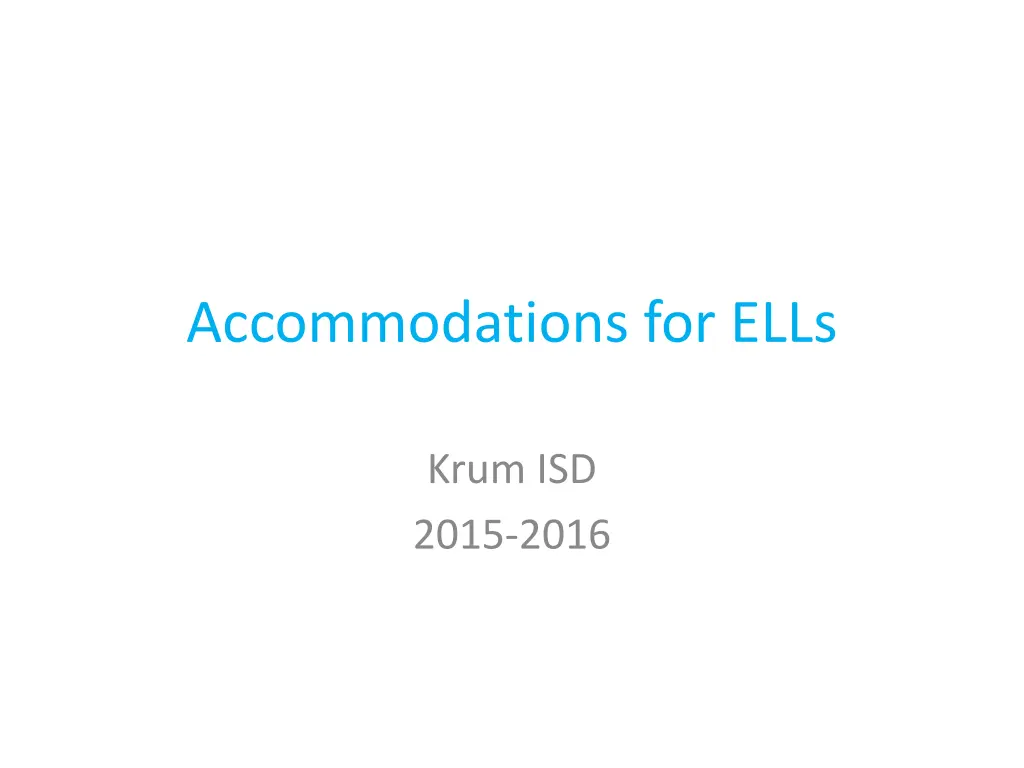
Effective Linguistic Accommodations for ELL Students
Explore linguistic accommodations for English Language Learners (ELLs) in Krum ISD during 2015-2016. Understand the types of accommodations and examples provided, such as sentence stems, use of native language, and pre-teaching vocabulary. Learn the importance of linguistic accommodations, aligned with Texas ELPS requirements. Discover how teachers can assign accommodations based on students' language proficiency levels.
Download Presentation

Please find below an Image/Link to download the presentation.
The content on the website is provided AS IS for your information and personal use only. It may not be sold, licensed, or shared on other websites without obtaining consent from the author. If you encounter any issues during the download, it is possible that the publisher has removed the file from their server.
You are allowed to download the files provided on this website for personal or commercial use, subject to the condition that they are used lawfully. All files are the property of their respective owners.
The content on the website is provided AS IS for your information and personal use only. It may not be sold, licensed, or shared on other websites without obtaining consent from the author.
E N D
Presentation Transcript
Accommodations for ELLs Krum ISD 2015-2016
Kinds of Accommodations for ELLs Affective Linguistic Cognitive 504 IEP
What are linguistic accommodations? Linguistic accommodations are language supports that decrease the language barrier ELLs experience when learning and demonstrating knowledge and skills in English.
Linguistic Accommodations Examples: Provide sentence stems for oral participation Allow use of drawing when writing Allow use of native language Bilingual dictionary Peer translation Extra time to complete assignments Pre-teach vocabulary with pictures Clarify the meaning of an unknown word using pictures, simple language, or gestures. etc.
Why Linguistic Accommodations? The Texas English Language Proficiency Standards (ELPS) require all teachers to linguistically accommodate the instruction of ELLs in their classes commensurate with the students English language proficiency levels.
What does this mean? Unlike with 504 or IEP accommodations, the teacher is expected to change linguistic accommodations over time, as he/she sees how the ELL student improves his/her English language skills. No LPAC meeting is required to change these accommodations. However, the teacher can ask for the support of LPAC committee or members of the LPAC. Cho Chang L. Accommodations for writing in classroom. Use of simple sentence stems and allow use of native language. Use of high- frequency word list and bilingual dictionary. Allow drawing in her writing. BOY MOY EOY Beginner Beginner writer writer Intermediate writer
How do I Assign Linguistic Accommodations? ELPS Training Use your PLD s throughout the year! TELPAS Training
Proficiency Level Descriptors (PLDs) The PLDs are the rubrics teachers use to determine students English language proficiency for ongoing formative assessment and the spring TELPAS administration. Originally developed for TELPAS, the PLDs were incorporated into the Texas English language proficiency standards (ELPS) in the 2007 2008 school year to reinforce their use in instruction. TEA 8
ELPS-TELPAS Proficiency Level Descriptors Grades K 12 Listening
Sets of PLDs Listening Grades K 12 Speaking Grades K 12 Reading Grades K 1 Grades 2 12 Writing Grades K 1 Grades 2 12
Key Features of Each Proficiency Level Beginning Little or no English ability Intermediate Limited ability, simple language structures, high-frequency vocabulary, routine contexts Advanced Grade appropriate, with second language acquisition support Advanced High Grade appropriate, with minimal second language acquisition support
So, what should I do? Look at BOY accommodations Record new linguistic accommodations. Look at last year s TELPAS results Adjust linguistic accommodations if needed. Use PLD s to see if student has made progress.
